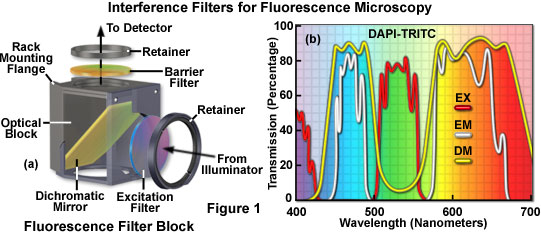Practical Aspects of Fluorescence Filter Combinations
Section Overview:
The terminology applied to fluorescence filters has become a jumble as a result of various initials utilized by different manufacturers to identify their filters. In this section, we attempt to make some order of this confusing terminology and specifically address how the various filter combinations can be utilized with specific fluorophores. Basically there are three categories of filters to be sorted out: exciter filters, barrier filters and dichromatic beamsplitters (dichroic mirrors), which are usually combined to produce a filter cube or block similar to the one illustrated in Figure 1. Proper selection of filters is the key to successful fluorescence microscopy.

The following sections contain links to review articles and interactive Java tutorials describing a variety of fluorescence filter combinations from the major manufacturers. Additional information is provided with regards to illumination excitation balancers, selection of fluorophores, and matching specific probes with filter combinations.
Review Articles
Brief Overview of Fluorescence Filters
A wide spectrum of filter cubes is available from most major manufacturers, which now produce filter sets capable of imaging most of the common chromophores in use today.
Basic Aspects of Light Filters
Filters work by absorbing light, while others reflect unwanted light, but pass a selected region of wavelengths. Some filters operate by interference and can be adjusted to pass narrow bands of light while reflecting all others.
Introduction to Fluorophores
Laser scanning confocal microscopy relies on secondary fluorescence emission as an imaging mode, due to the high degree of sensitivity afforded by the technique coupled with the ability to specifically target structural components.
Acousto-Optic Tunable Filters (AOTFs)
Several benefits of the AOTF combine to greatly enhance the versatility of the latest generation of confocal instruments, and these devices are becoming popular for control of excitation wavelength ranges and intensity.
Interference Filters for Fluorescence Microscopy
The utilization of highly specialized thin film interference filters have enhanced the versatility and scope of fluorescence techniques, far beyond the capabilities afforded by the earlier use of gelatin and glass filters.
Spectral Bleed-Through Artifacts in Confocal Microscopy
Spectral bleed-through of fluorescence emission, which occurs due to the very broad bandwidths and asymmetrical spectral profiles exhibited by many of the fluorophores, is a problem that must be addressed in microscopy.
Interactive Java Tutorials
Interference Filters
Explore how interference filters operate by selectively transmitting constructively reinforced wavelengths while simultaneously eliminating unwanted light with this interactive tutorial.
Matching Fluorescence Filter Blocks with Fluorescent Probes
Examine the fluorophore characteristics necessary to maximize the efficiency of excitation and emission in conjunction with current Olympus fluorescence filter blocks.
Fluorescent Probe Excitation Efficiency
Fluorescence intensity is proportional to the product of the extinction coefficient and quantum yield. See how this relationship can be utilized to match fluorophores with specific lasers.
Acousto-Optic Tunable Filters
The acousto-optic tunable filters (AOTF) are increasingly being employed to modulate the wavelength and amplitude of illuminating laser light in the latest generation of confocal microscopes as shown in this tutorial
Liquid Crystal Tunable Filters
The LCTF (Liquid Crystal Tunable Filters) utilized in this tutorial is an example of a Lyot filter, in which four polarizers are separated by three layers of liquid crystals sandwiched between birefringent crystals.
Fluorochrome and Fluorescence Filter Combination Data Tables
In this section, we have compiled a listing of data on the most popular fluorochromes including excitation and emission characteristics, suggested cube utilization, and application data. This information can be accessed through the links provided below.
Fluorochrome Data Table
As a guide to fluorophores for confocal and widefield fluorescence microscopy, the table presented in this section lists many commonly-used fluorochromes, with their respective peak absorption and emission wavelengths and suggested laser illumination sources. While the authors assume responsibility for the accurate reporting of the data as published in various reliable sources, several caveats must be given. In reviewing the literature, one will frequently find somewhat different data supplied for the identical fluorochrome.
Ex/Em/Cubes/Applications
A comprehensive table of excitation and emission spectral maxima, and excitation suggestions, listed by application.
Excitation and Emission Data
Excitation and emission maximum wavelengths listed alphabetically by fluorochrome name.
Fluorochromes and Suitable Cubes
A compilation of spectral characteristics of major fluorochromes as well as sample fluorescence photomicrographs are also included.
Olympus Fluorescence Mirror Units
Designed to present the technical specifications of UIS fluorescence mirror units, this brochure offers a detailed unit selection chart based on fluorochrome characteristics.
このページはお住まいの地域ではご覧いただくことはできません。